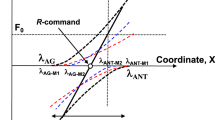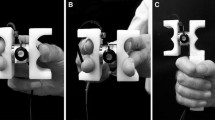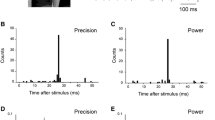Abstract
Electromyographic (EMG) activity was examined in six normal subjects, producing low isometric forces between thumb and index finger in a visually guided step-tracking task. Target forces ranged between 0.5 and 3.0 N. EMG activity of all 15 muscles acting on thumb or index finger was screened with simultaneous recordings of up to 8 muscles. Linear regression was applied to quantify the EMG activity as a function of force. The intrinsic muscles and the long flexors of the index finger had a tight relation to force, as indicated by the high correlation coefficient, as did the adductor and short flexor of the thumb. In contrast, the long extensors of the index finger did not show force-related activity. The other muscles, including the long flexor and extensor of the thumb, had varying,on average moderate, correlations to force. The slope of the regression lines, a measure for the amount of EMG modulation with increasing force, revealed the same trends. Thus the majority of the intrinsic muscles were as closely related to force as the long flexors, suggesting a more important role in production of low isometric forces in the grip than previously believed, perhaps even a primary role. Systematic interindividual differences were rarely observed. Analysis of the trialby-trial variability of EMG activity revealed that for most muscles the observed scatter was produced by varying background activity and was not a random fluctuation of relative increases in activity from one force level to the next.
Similar content being viewed by others
References
Basmajian JV, DeLuca CJ (1985) Muscles alive. Their functions revealed by electromyography. Williams & Wilkins, Baltimore
Bernstein N (1967) The co-ordination and regulation of movements. Pergamon, Oxford
Boivin G, Wadsworth GE, Landsmeer JMF, Long C (1969) Electromyographic kinesiology of the hand: muscles driving the index finger. Arch Phys Med Rehab 50:17–26
Chao EYS, Opgrande JD, Axmear FE (1976) Three-dimensional force analysis of finger joints in selected isometric hand functions. J Biomech 9:387–396
Chao EYS, An K-N, Cooney WP, Linscheid RL (1989) Biomechanics of the hand. World Scientific, Singapore
Clamann HP, Broecker MS (1979) Relation between force and fatiguability of red and pale skeletal muscles in man. Am J Phys Med 58:70–85
Close JR, Kidd CC (1969) The functions of the muscles of the thumb, the index and the long fingers. J Bone Joint Surg Am 51 (8):1601–1620
Cole KJ, Abbs JH (1987) Kinematic and electromyographic responses to perturbation of a rapid grasp. J Neurophysiol 57:1498–1510
Cole KJ, Abbs JH (1988) Grip force adjustments evoked by load force perturbation of a grasped object. J Neurophysiol 60:1513–1522
Cooney WP III, Chao YS (1977) Biomechanical analysis of static forces in the thumb during hand function. J Bone Joint Surg Am 59:27–36
Delagi EF, Peretto A (1980) Anatomic guide for the electromyographer (the limbs). Thomas, Springfield, Ill
Edin BB, Westling G, Johansson RS (1992) Independent control of human finger-tip forces at individual digits during precision lifting. J Physiol (Lond) 450:547–564
Forrest WJ, Basmajian JV (1965) Functions of human thenar and hypothenar muscles. J Bone Joint Surg Am 47:1585–1594
Johansson RS, Westling G (1984) Roles of glabrous skin receptors and sensorimotor memory in automatic control of precision grip when lifting rougher or more slippery objects. Exp Brain Res 56:550–564
Johansson RS, Westling G (1988) Coordinated isometric muscle commands adequately and erroneously programmed for the weight during lifting task with precision grip. Exp Brain Res 71:59–71
Kendall FP, McCreary EK (1983) Muscles testing and function. Williams & Wilkins, Baltimore
Ketchum LD, Thompson D, Pocock GS, Wallingford D (1978) A clinical study of forces generated by the intrinsic muscles of the index finger and the extrinsic flexor and extensor muscles of the hand. J Hand Surg 3:571–578
Kilbreath SL, Gandevia SC (1993) Neural and biomechanical specializations of human thumb muscles revealed by matching weights and grasping objects. J Physiol (Lond) 472:537–556
Lawrence JH, De Luca CJ (1983) Myoelectric signal vs force relationship in different human muscles. J Appl Physiol 54:1653–1659
Long C (1968) Intrinsic-extrinsic muscle control of the fingers. J Bone Joint Surg Am 50:973–984
Long C, Conrad PW, Hall EA, Furler SL (1970) Intrinsic-extrinsic muscle control of the hand in power grip and precision handling. J Bone Joint Surg Am 52:853–867
Macpherson JM (1991) How flexible are muscle synergies? In: Humphrey DR, Freund H-J (ed) Motor control: concepts and issues. Wiley, Chichester, pp 33–47
Maier MA, Hepp-Reymond M-C, Meyer M (1990) EMG coactivation patterns and isometric grip force in human (abstract). Eur J Neurosci [Suppl] 3:65
Maier MA, Hepp-Reymond, M-C, Meyer M (1991) EMG coactivation patterns in precision grip: timing and spectral analysis (abstract). Eur J Neurosci [Suppl] 4:97
Maier MA, Hepp-Reymond M-C (1995) EMG activation patterns during force production in precision grip. II. Muscular synergies in the spatial and temporal domain. Exp Brain Res 103:123–136
Matheson AB, Sinclair DC, Skene WG (1970) The range and power of ulnar and radial deviation of the fingers. J Anat 107:439–458
Muir RB (1985) Small hand muscles in precision-grip: a corticospinal prerogative? Exp Brain Res 10:155–174
Muir RB, Lemon RN (1983) Corticospinal neurons with a special role in precision grip. Brain Res 261:312–316
Ranney D, Wells R (1988) Lumbrical muscle function as revealed by a new and physiological approach. Anat Rec 222:110–114
Romanes GJ (1981) Cunningham's textbook of anatomy. Oxford University Press, Oxford
Rufener EA, Hepp-Reymond M-C (1988) Muscle coactivation patterns in the precision grip. Adv Biosci 70:169–172
Smith AM (1981) The coactivation of antagonist muscles. Can J Physiol Pharmacol 59:733–747
Smith AM, Bourbonnais D (1981) Neuronal activity in cerebellar cortex related to control of prehensile force. J Neurophysiol 45:286–303
Stack HG (1962) Muscle function in the fingers. J Bone Joint Surg Br 44:899–909
Weathersby HT, Sutton LR, Krusen UL (1963) The kinesiology of uscles of the thumb: an electromyographic study. Arch Phys Med 44:321–326
Woods JJ, Bigland-Ritchie B (1983) Linear and nonlinear surface EMG/force relationships in human muscles. Am J Phys Med 62:287–299
Author information
Authors and Affiliations
Rights and permissions
About this article
Cite this article
Maier, M.A., Hepp-Reymond, MC. EMG activation patterns during force production in precision grip. Exp Brain Res 103, 108–122 (1995). https://doi.org/10.1007/BF00241969
Received:
Accepted:
Issue Date:
DOI: https://doi.org/10.1007/BF00241969




